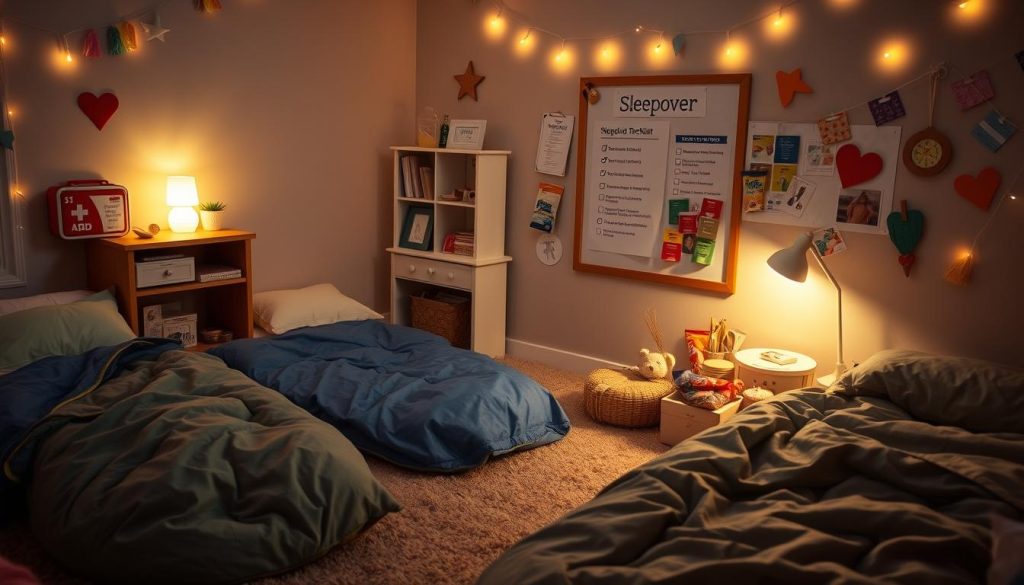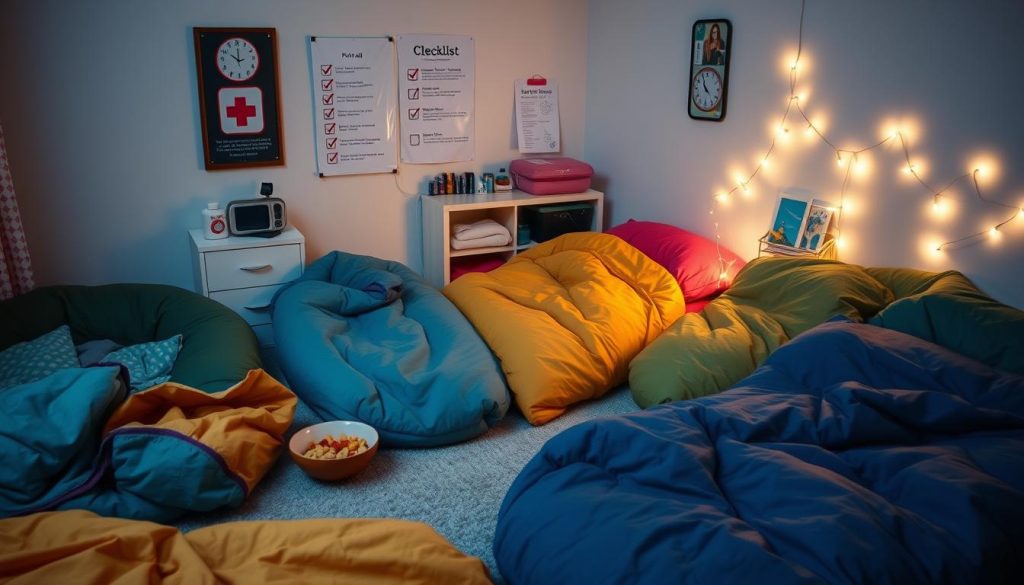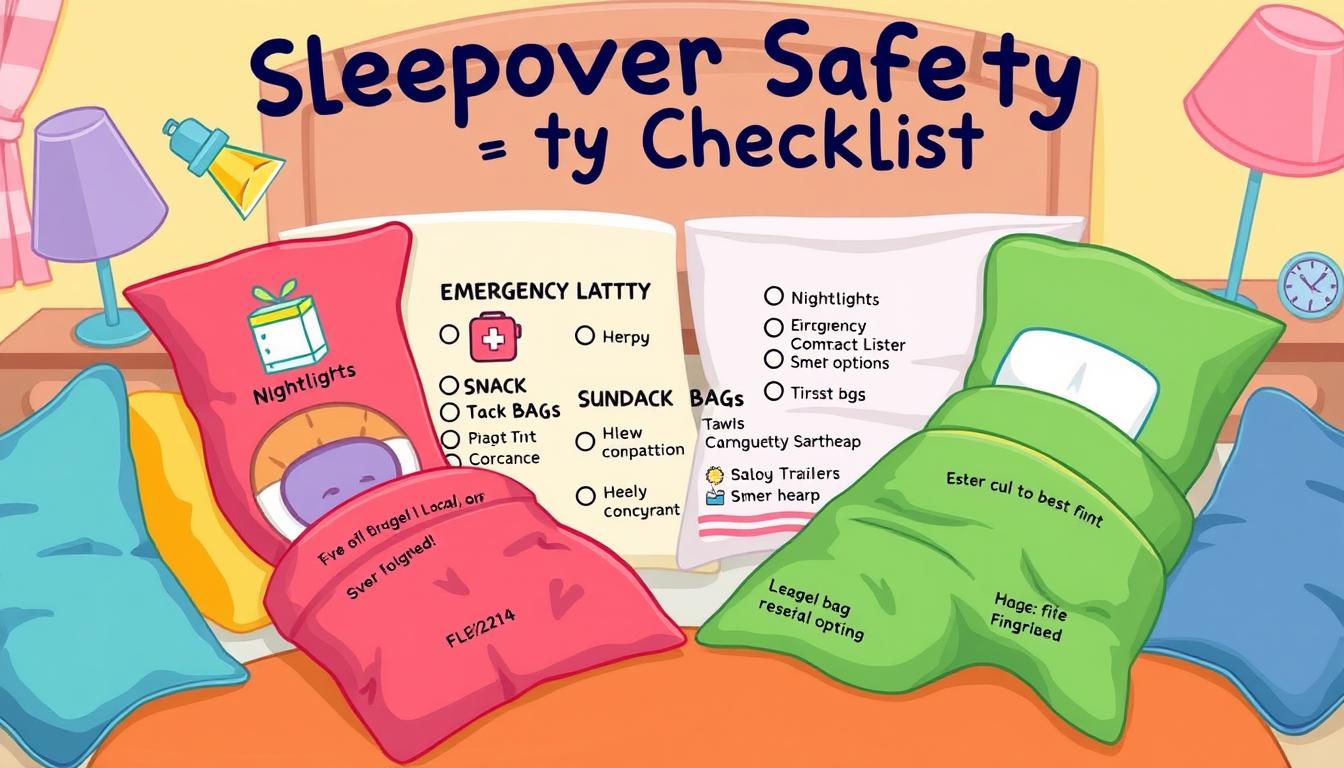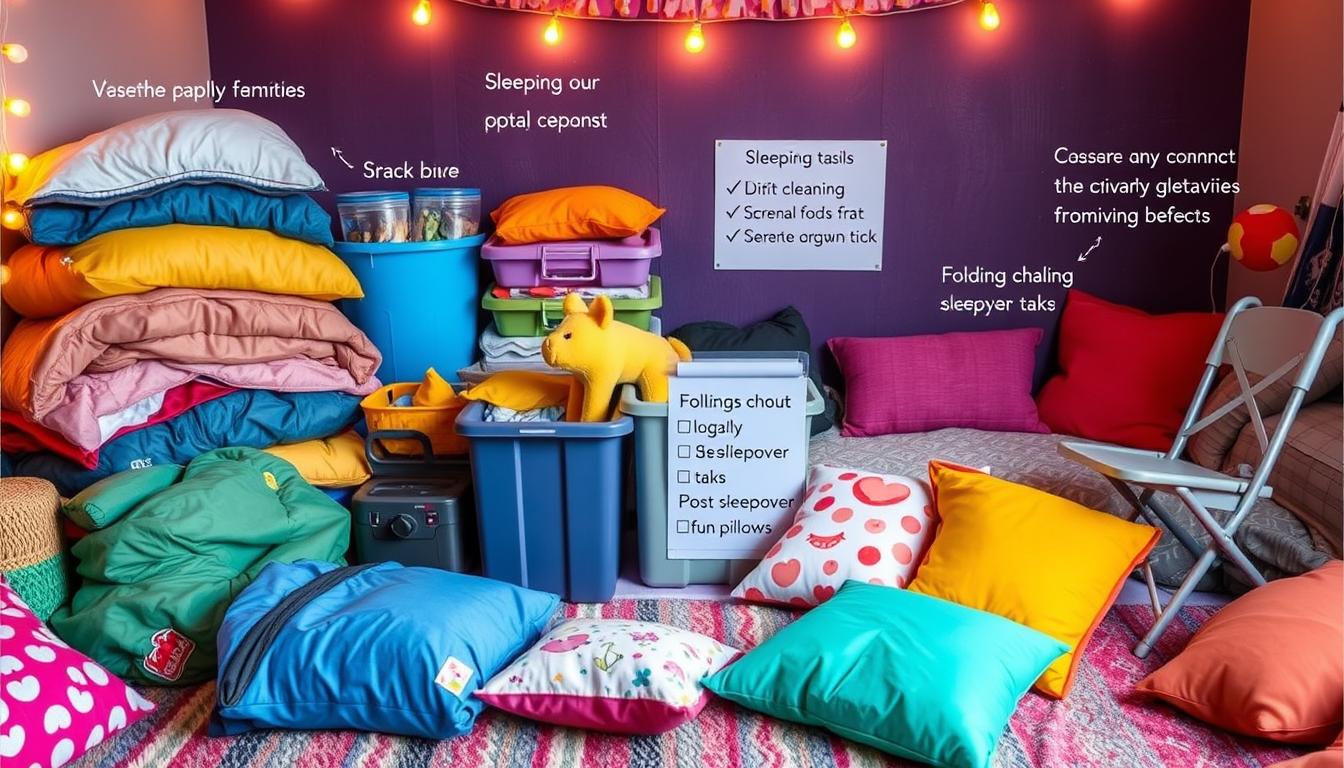Are you ready for the unexpected at your child’s sleepover? Sleepover safety is complex, with many factors to consider. As a parent, it’s tough to ensure your child’s safety, given that most child abuse comes from someone known to the family. It’s key to make smart choices for a safe sleepover.
This guide will give you the tools you need for sleepover safety. We’ll cover everything from your child’s readiness to creating a safety checklist. By knowing the risks and talking openly with your child and the host family, you can keep them safe. Ensuring sleepover safety means giving you and your child the knowledge and tools you need.
Understanding the Importance of Sleepover Safety
Sleepovers are great for kids to make friends and grow independent. It’s key to know the risks to keep them safe. Parents need to set clear safety rules and precautions.
Recognizing Potencial Risks for Children
Most sleepovers are for kids aged 7-8. But, parents worry about safety a lot. About 90% of child abuse is by someone known to the child.
Young kids can’t talk well, making them more at risk. So, it’s vital to watch them closely and take safety steps.
Statistics on Child Safety During Sleepovers
Knowing the facts can help parents relax. About 60-70% of parents worry about their kids’ safety at sleepovers. Yet, 75% of kids aged 8-12 have been to one.
Studies say sleepovers can boost kids’ confidence and social skills by 40%. Though safety issues are rare, they can happen. Parents worry about 30% of older kids or family members.
Common Concerns for Parents
Talking to other parents can help. About 50% ask about safety before letting their kids go. Most believe sleepovers help build community bonds. Sharing experiences can lead to valuable insights, and parents often exchange sleepover tips for energy management to ensure that the kids are well-rested and engaged throughout the night. Many suggest setting clear boundaries and schedules to facilitate a smoother experience, allowing kids to enjoy each other’s company while also getting enough rest. Ultimately, fostering open communication among parents can enhance the overall sleepover experience, making it a positive event for everyone involved.
Almost 65% of families have rules for using devices at sleepovers. But, peer pressure can affect kids’ actions. So, it’s important to talk about safety.
Pre-Sleepover Preparations
Getting ready for a sleepover needs careful thought to make sure your child has a good time. It’s important to check if your child is ready for this big adventure. Some kids love sleepovers, while others might feel scared or unsure.
Talking openly with your child can help you understand their feelings. This way, you can see if they’re truly ready for a sleepover.
Assessing Your Child’s Readiness
Think about your child’s age and if they’ve stayed away from home before. Knowing how they handle new situations is key. This helps you decide if it’s the right time for a sleepover.
Discussing the Sleepover with Your Child
Have a chat with your child about what a sleepover is like. Talk about their worries and what they can expect at night. *Good communication* means telling them who will be there to keep them safe.
Making a Safety Plan with Your Child
Creating a safety plan is a big part of sleepover safety. Work with your child to make a list of who they can call if they need help. Set up check-ins, like calls or texts, to make them feel supported.
Talk about staying safe online and making sure the house is safe. Also, discuss rules for socializing to keep everyone safe and happy.

Sleepover Safety Protocol Checklist
Creating a sleepover safety checklist makes parents feel more at ease. Talking openly and being well-prepared can make the sleepover safe and fun. Here’s how to ensure your child’s sleepover is safe.
Key Questions to Ask the Host Family
Before your child goes to a sleepover, it’s important to ask the host family some key questions. Find out:
- Who else will be staying in the home?
- What sleeping arrangements have been made?
- Will a trusted adult supervise the children throughout the night?
- What are the expected activities during the sleepover?
- Do any guests have allergies or sensitivities that need to be accounted for?
These questions help ensure the sleepover is safe and can ease any worries.
Creating a Communication Plan with Your Child
It’s vital to have a plan for how your child can reach you if needed. Talk about:
- Make sure your child has your phone number saved or written down.
- Tell them to speak up if they’re feeling uncomfortable.
- Teach them a secret signal or phrase to use if they’re scared.
These steps help both you and your child feel more secure and highlight the importance of safety.
Checking for Safe Environments
Visiting the host’s home can give you peace of mind about safety. Look for:
- Are dangerous items, like weapons or medications, out of reach?
- Are the sleeping arrangements safe and suitable?
- Is the home welcoming and safe for kids?

| Checklist Item | Action Required |
|---|---|
| Ask Host Family Key Questions | Inquire about other guests, sleeping arrangements, and supervision. |
| Create Communication Plan | Establish a method for your child to contact you during the sleepover. |
| Visit the Host’s Home | Inspect for safety hazards and appropriate sleeping conditions. |
Essential Sleepover Safety Guidelines for Parents
Keeping your child safe during sleepovers is key. Good communication and planning are vital. These tips will help you ensure a safe sleepover for your child, giving you both peace of mind.
Establishing Open Communication with Other Parents
Talking about safety with the host family is a must. About 50% of parents agree on this. Discussing things like sleeping spots, medicine, and dangers is important. It helps clear up any worries before the sleepover.
Familiarizing Yourself with the Home Environment
Visiting the host’s home is a good idea. Around 25% of parents feel better knowing their child’s surroundings. Check for dangers and the overall feel of the place. Ask about emergency plans and safety, like where medicines and guns are kept.
Ensuring Adult Supervision throughout the Night
Make sure an adult will be there all night. Studies show 55% of parents feel safer with an adult watching. Having someone there can help avoid problems and solve them quickly.
| Safety Aspect | Percentage of Parents Concerned |
|---|---|
| Communication with Host Family | 50% |
| Home Assessments | 25% |
| Adult Supervision | 55% |
| Children’s Comfort and Personal Items | 45% |
| Emergency Concerns and Code Words | 70% |
Sleepover Safety Tips for Kids
Getting ready for a sleepover is more than just picking out pajamas and snacks. It’s about teaching kids how to stay safe and have fun. By teaching them about personal boundaries, trusting their instincts, and having a code word for emergencies, you’re helping them have a great time.
Teaching Your Child About Personal Boundaries
Knowing about personal boundaries is vital for sleepover safety. Teach your child what areas are off-limits and to always ask before touching others. Talking about what’s okay and what’s not helps them feel safe and confident around others.
Empowering Your Child to Trust Their Instincts
Teach your child to trust their gut feelings. If something feels wrong, it’s okay to say no and ask for help. This way, they can handle uncomfortable situations better, making sleepovers safer for them.
Setting Up a Code Word for Emergency Situations
A secret code word is a great safety tool for sleepovers. Pick a simple word or phrase that your child can use if they feel scared or need help. This way, they can communicate their needs without drawing attention. It makes them feel supported and lets them know they can always count on you.
Post-Sleepover Follow-Up
It’s important to talk to your child after a sleepover. This helps you understand how they felt and what happened. Start by asking them about their night, including the fun parts and any problems.
Talking openly makes them feel heard and shows safety is a big deal. It’s a chance to learn more about their experience and how to stay safe in the future.
Checking in with Your Child About Their Experience
Ask your child about the sleepover’s atmosphere. Find out if they felt safe and comfortable. It’s key to know their thoughts on the host’s home, as kids notice things adults might miss.
Encourage them to share any important moments or feelings from the night. This is a great time to talk about safety and how to handle feelings.
Discussing Any Concerns or Issues
Listen to any worries your child has. This could be small issues or big safety concerns. Talking openly builds trust and shows they can come to you with anything.
This approach helps them feel confident in speaking up if they’re ever worried again. It also makes them more aware of safety during sleepovers.
Reinforcing Safety Conversations for Future Sleepovers
Look back on the sleepover together, focusing on the good and what could be better next time. Making safety talks a regular thing is key, as many parents worry about safety at sleepovers.
Emphasize the need to ask about safety at future sleepovers and have a plan for emergencies. By discussing these topics, you help your child develop a safety-first mindset.
Conclusion
Keeping sleepovers safe is a big job that needs careful planning and talking openly. By taking the right steps, you can make sure your child has a great time. It’s important to talk about safety rules with your child so they know how to stay safe.
When getting ready for sleepovers, remember that watching over your child closely can really help. Studies show that this can cut down on accidents by up to 70%. Also, making sure homes are safe and talking with other parents can make sleepovers safer. This way, you’re not just keeping your child safe, but also helping them grow and make friends.
By making sure sleepovers are safe and talking with your child about safety, you’re setting them up for fun times. Keep having these talks to help your child feel safe and happy with their friends.
Source Links
- Safe Sleepovers
- 7 Tips for a Safer Sleepover – Child Rescue Coalition
- Sleepover Safety — Child Abuse Prevention Service
- Your guide to sleepover safety
- 8 Questions for Safer Sleepovers – Project Harmony
- Safer Sleepovers
- SLEEPOVERS – A CHECKLIST. – Sue Atkins The Parenting Coach
- Sleepover Check List – JoFrost.com
- Tips for Families: A Guide to Safe Sleepovers
- Tips for Parents: A Guide to Safe Sleepovers
- Safe Sleepovers Checklist – Child Safety Pledge
- The 5 Things You Need To Know For Safe Sleepovers
- These Are the Questions Parents Need to Ask Before Their Kid Goes Over to a Friend’s House for the First Time – Washingtonian
- How To Ensure Safety At Your Child’s Sleepover | My Beautiful Adventures
- Child Safety During Sleepovers and Playdates: Guidelines for Parents
- Blog – How to Have a Fire Safe Sleepover




